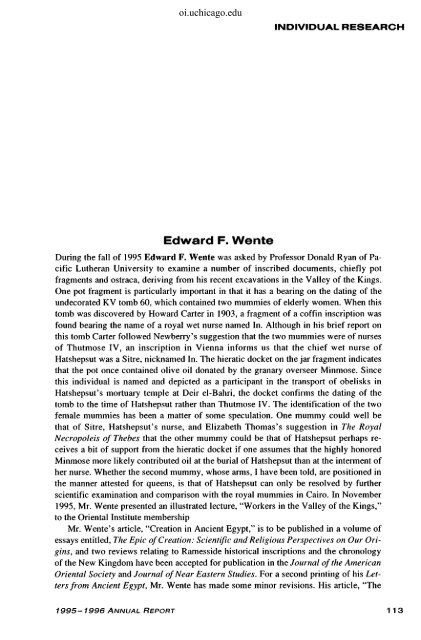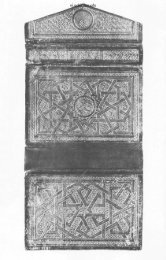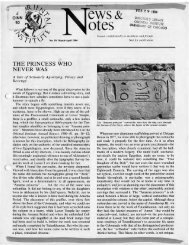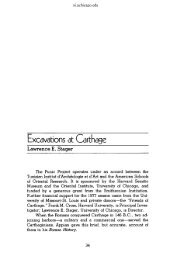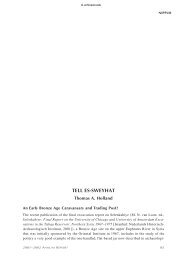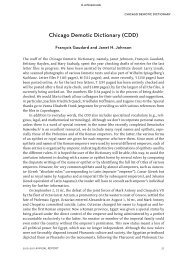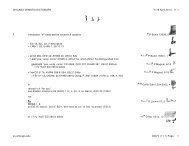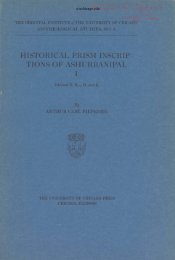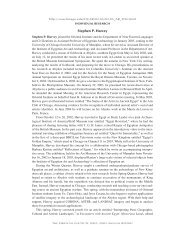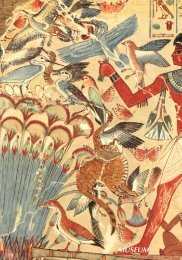Edward F. Wente - Oriental Institute
Edward F. Wente - Oriental Institute
Edward F. Wente - Oriental Institute
You also want an ePaper? Increase the reach of your titles
YUMPU automatically turns print PDFs into web optimized ePapers that Google loves.
oi.uchicago.edu<br />
<strong>Edward</strong> F. <strong>Wente</strong><br />
INDIVIDUAL RESEARCH<br />
During the fall of 1995 <strong>Edward</strong> F. <strong>Wente</strong> was asked by Professor Donald Ryan of Pacific<br />
Lutheran University to examine a number of inscribed documents, chiefly pot<br />
fragments and ostraca, deriving from his recent excavations in the Valley of the Kings.<br />
One pot fragment is particularly important in that it has a bearing on the dating of the<br />
undecorated KV tomb 60, which contained two mummies of elderly women. When this<br />
tomb was discovered by Howard Carter in 1903, a fragment of a coffin inscription was<br />
found bearing the name of a royal wet nurse named In. Although in his brief report on<br />
this tomb Carter followed Newberry's suggestion that the two mummies were of nurses<br />
of Thutmose IV, an inscription in Vienna informs us that the chief wet nurse of<br />
Hatshepsut was a Sitre, nicknamed In. The hieratic docket on the jar fragment indicates<br />
that the pot once contained olive oil donated by the granary overseer Minmose. Since<br />
this individual is named and depicted as a participant in the transport of obelisks in<br />
Hatshepsut's mortuary temple at Deir el-Bahri, the docket confirms the dating of the<br />
tomb to the time of Hatshepsut rather than Thutmose IV. The identification of the two<br />
female mummies has been a matter of some speculation. One mummy could well be<br />
that of Sitre, Hatshepsut's nurse, and Elizabeth Thomas's suggestion in The Royal<br />
Necropoleis of Thebes that the other mummy could be that of Hatshepsut perhaps receives<br />
a bit of support from the hieratic docket if one assumes that the highly honored<br />
Minmose more likely contributed oil at the burial of Hatshepsut than at the interment of<br />
her nurse. Whether the second mummy, whose arms, I have been told, are positioned in<br />
the manner attested for queens, is that of Hatshepsut can only be resolved by further<br />
scientific examination and comparison with the royal mummies in Cairo. In November<br />
1995, Mr. <strong>Wente</strong> presented an illustrated lecture, "Workers in the Valley of the Kings,"<br />
to the <strong>Oriental</strong> <strong>Institute</strong> membership<br />
Mr. <strong>Wente</strong>'s article, "Creation in Ancient Egypt," is to be published in a volume of<br />
essays entitled, The Epic of Creation: Scientific and Religious Perspectives on Our Origins,<br />
and two reviews relating to Ramesside historical inscriptions and the chronology<br />
of the New Kingdom have been accepted for publication in the Journal of the American<br />
<strong>Oriental</strong> Society and Journal of Near Eastern Studies. For a second printing of his Letters<br />
from Ancient Egypt, Mr. <strong>Wente</strong> has made some minor revisions. His article, "The<br />
1995-1996 ANNUAL REPORT 113
RESEARCH<br />
oi.uchicago.edu<br />
Scribes of Ancient Egypt," appeared in the fourth volume of Civilizations of the Ancient<br />
Near East, edited by Jack M. Sasson.<br />
114 THE ORIENTAL INSTITUTE


